RDP 9308: Balance Sheet Restructuring and Investment 3. Trends in Funding and Investment
June 1993
- Download the Paper 96KB
3.1 Balance Sheet and Investment Expansion 1984/85 – 1989/90
There have been several distinct phases in the evolution of corporate balance sheets over the past decade. Early in the 1980s, investment was declining sharply after a large rise at the end of the 1970s, which had been associated with the rise in real energy prices at that time. Factors driving the downturn were the big rise in labour costs, in an environment of weakening real growth. This depressed profitability, and incentives to invest fell sharply.
This phase came to an end in the second year of the recovery from the 1982/83 recession. By that time, output was rising strongly, in the context of a rapid international recovery. Wages policies had simultaneously allowed a rapid restoration in the share of national income going to profits. Consequently, incentives to invest improved. Graph 1, for example, shows two measures of the rate of return on the aggregate capital stock taken from the ABS, and a conventional measure of the ratio of corporate gross operating surplus to GDP.

All these measures show a sharp rise in 1983/84 and a further increase in 1984/85. By the latter year, investment in real assets – both plant and equipment and construction – by the business community was responding strongly to the enhanced incentives (Graph 2). Share prices rose rapidly, reflecting the financial markets' confidence in future profitability.

This period of strong profitability, confidence and rising investment continued over several years. Between 1983/84 and 1989/90, aggregate measures of the profit share averaged levels not seen since the late 1960s; real business investment doubled; the private corporate sector's aggregate capital stock increased by over a quarter in real terms; and the share-market value of the listed company sector more than trebled, despite the fall in share prices in October 1987.
These trends were reflected in accounting measures of the corporate sector's balance sheets. Corporate balance sheets grew very quickly until 1989/90 (Graphs 3 and 4).[9] Total assets of the corporate sector increased fourfold in nominal terms and more than doubled in real terms. They also increased relative to corporate sales. The ratio of assets to sales stood at 0.97 in 1981/82 and increased to 1.15 in 1989/90.


The structure of the corporate sector's balance sheet also changed over time. On the asset side, both fixed and financial assets became a larger part of the sector's total assets (Table 1 and Graph 3). Stocks have been steadily declining as a share of total assets. Financial assets have been the fastest growing component of total assets.
| Ratio | Company Finance Sample | STATEX Sample | |||
|---|---|---|---|---|---|
| 1971/72–1975/76 | 1976/77–1980/81 | 1981/82–1985/86 | 1986/87–1990/91 | 1991/92 | |
| STOCKS | |||||
| Liabilities | |||||
| Debt/Total Assets | 0.23 | 0.22 | 0.26 | 0.32 | 0.31 |
| Equity/Total Assets | 0.53 | 0.51 | 0.50 | 0.45 | 0.46 |
| Assets | |||||
| Stock/Total Assets | 0.22 | 0.23 | 0.15 | 0.11 | 0.10 |
| Financial/Total Assets | 0.12 | 0.14 | 0.18 | 0.20 | 0.15 |
| Fixed/Total Assets | 0.46 | 0.43 | 0.47 | 0.45 | 0.49 |
| Financial/Fixed Assets | 0.26 | 0.32 | 0.38 | 0.44 | 0.31 |
| FLOWS | |||||
| Total Sources/Δ Fixed Assets | 2.41 | 2.16 | 1.88 | 2.26 | 2.88 |
| Δ Debt/Δ Fixed Assets | 0.53 | 0.45 | 0.63 | 0.64 | −0.09 |
| ΔEquity/Δ Fixed Assets | 0.27 | 0.29 | 0.36 | 0.32 | 1.10 |
| Cash Flow/Δ Fixed Assets | 1.60 | 1.41 | 0.89 | 1.31 | 1.87 |
On the liabilities side, debt became a more important source of finance, increasing from just over 20 per cent of total assets in the early 1970s to 31 per cent in the second half of the 1980s (Table 1 and Graph 4).
Graphs 5 and 6 provide more detail on the sources and uses of corporate funding in the 1980s. As always, the corporate sector relied on a number of sources of finance to fund the expansion in assets (Graph 5). The recovery in profits, the liberalisation of financial markets and the increase in share prices during the 1980s was conducive to increases in all sources of funding. The recovery in economic activity and the increase in the profit share had a profound effect on cash flows, which are the dominant source of funding for the bulk of companies. Cash flows rose continually after 1982/83 until plateauing in 1988/89. However, with the strong incentives to invest, investment (in both fixed and financial assets) outstripped cash flows and companies increased external raisings of funds. Both sources of external funding – debt and new equity raisings – grew rapidly. However, over the course of the decade there was a shift towards greater reliance on debt. Debt raisings were particularly high between 1985/86 and 1988/89. This increased indebtedness was supported by higher cash flows and rising equity prices which boosted the perceived collateral of many companies.


One of the legacies of the switch towards debt financing in the 1980s is higher levels of corporate gearing. Graph 7a shows a measure of gearing using book values of debt and equity and Graph 7b shows a measure using the market value of equity. The factors contributing to this rise in gearing have been documented elsewhere.[11]
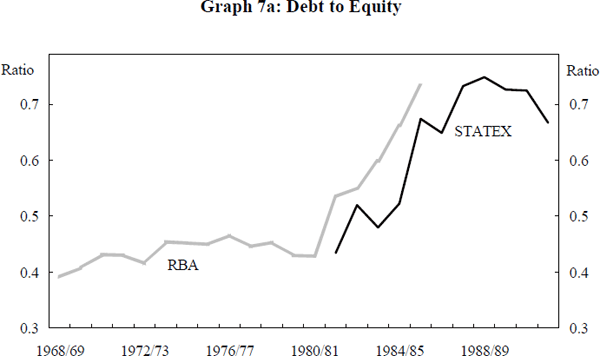
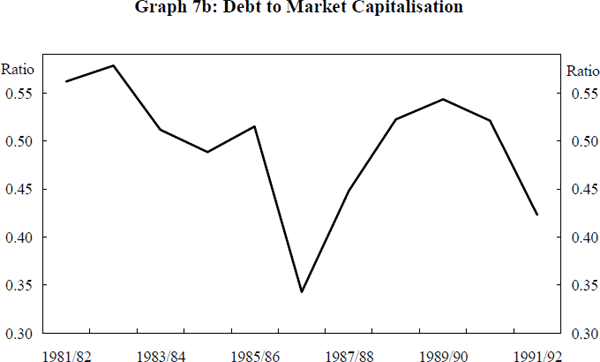
As a result of this higher gearing the proportion of profits needed to repay interest expenses rose sharply. Graph 8 plots the ratio of operating profits to net interest payments. This is a measure of firms' current capacity to meet debt obligations. Interest cover has been declining since the 1970s reflecting higher nominal interest rates and the build-up of debt.

Rising interest rates between 1988 and 1990 and the ensuing slowdown in the economy and earnings in 1990 saw interest cover slip further. In addition, the value of collateral backing corporate debt fell sharply. These factors resulted in the financial distress of some of those firms that over-borrowed and ushered in the second phase of the development: the period of balance sheet consolidation and falling investment.
3.2 Balance Sheet Restructuring Post 1989/90
3.2.1 Process and Extent of Repair
The period of rapid corporate balance sheet expansion came to a halt and balance sheet growth has been very sluggish since 1988/89 (Graph 3).[12] In addition, firms began to restructure their balance sheets. The restructuring has occurred on both the asset and liability sides.
On the liability side, firms began to reduce raisings of external finance from about 1989/90 (Graph 5 and Table 2). Recourse to external finance fell sharply between 1989/90 and 1991/92. The increase in debt of our sample of companies in the listed corporate sector in 1989/90 was half that of the previous year. It was negligible the following year, and firms actually reduced debt outstanding in 1991/92. The other source of funds, equity raisings, were negligible through 1989/90 and 1990/91 as the weak equity market made the perceived cost of equity raisings high.
| 1989/90 | 1990/91 | 1991/92 | 1992/93 Sept | 1992/93 Dec | |
|---|---|---|---|---|---|
| Change in: | |||||
| Liabilities | 24.5 | 8.7 | 3.1 | 2.1 | 3.5 |
| –Debt | 23.6 | 9.3 | −9.7 | 0.0 | −1.7 |
| –Equity | 0.9 | −0.6 | 12.8 | 2.1 | 5.2 |
| Financial Assets | −6.2 | −5.6 | −2.4 | −1.5 | 2.5 |
This adjustment was taking place against a background of declining cash flows. This constrained the extent to which firms could use internal funds to restructure their balance sheets. As a result, the need to adjust the liabilities side of corporate balance sheets had repercussions for firms' operating procedures and for their asset structure. Investment in fixed assets was pared back (Graphs 2 and 6). The fall in investment has been very large by historical standards. Non-residential construction has fallen sharply, which was to be expected given the oversupply of commercial property space in most central business districts. The fall in plant and equipment investment has been even more dramatic. In 1991/92, at around 6 per cent of GDP, it was at its lowest point in the past 40 years. Furthermore, firms began to reduce their holdings of financial assets in 1989/90 and 1990/91 in an attempt to fund the reduction in external finance (Graph 6 and Table 2). This reduction in financial assets will mitigate to some extent the improvement in corporate balance sheets resulting from lower debt exposures.
As a result of balance sheet restructuring, aggregate gearing has been reduced. Graph 9 contains a number of measures of corporate indebtedness. The first plots gearing – the ratio of debt to the book value of equity – of the 80 companies taken from the STATEX sample. This measure shows that gearing peaked at around 75 per cent in 1988/89 and then fell by around 8 percentage points to 67 per cent in 1991/92. This probably understates both the rise and subsequent fall in gearing. This is because the measure shown here is based on a constant sample of companies which have been in operation continuously over the ten years ending in 1991/92. Companies that geared up significantly during the 1980s and subsequently failed are excluded from this sample. Adding back some of these companies, in the top line in Graph 9, shows a much bigger rise and fall in gearing during the late 1980s.[14]
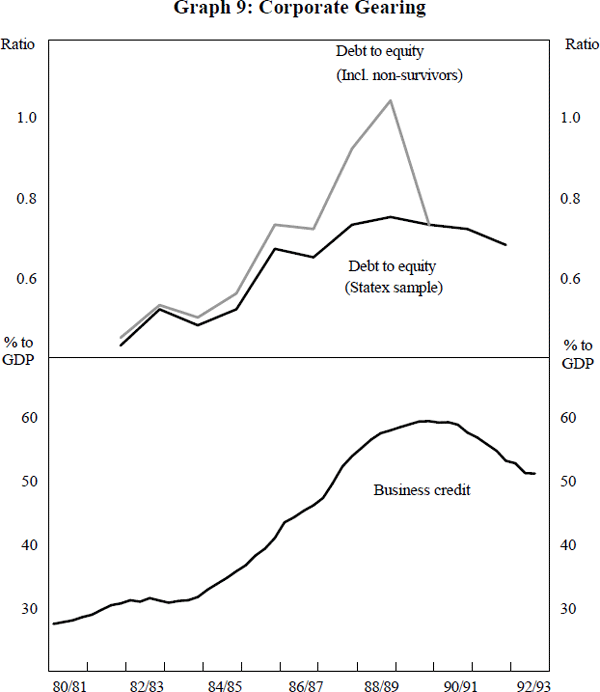
The comprehensive balance sheet data are only available up to 1991/92. The ratio of business credit to GDP – the line in the bottom panel of Graph 9 – suggests however, that the process of deleveraging has continued during 1992/93. Furthermore, new equity raisings gathered pace in 1992 (Table 2), as expectations of recovery led to somewhat higher share prices. This enabled a more rapid reduction in debt without major asset sales.
The process of balance sheet repair has been ongoing for several years and by 1992 more than 50 per cent of companies had reduced debt levels to around, or below, those that existed in the early 1980s. Graph 10 shows gearing for a sample of companies in 1988/89 and 1991/92. Most companies have lower gearing in 1991/92 than in 1988/89. Furthermore, most companies appear to be clustered around gearing levels that are not high; 64 per cent of companies in the sample had gearing ratios of less than 50 per cent per cent in 1991/92. Indeed, gearing levels of large Australian companies are lower than the levels in many major industrial countries.[15]
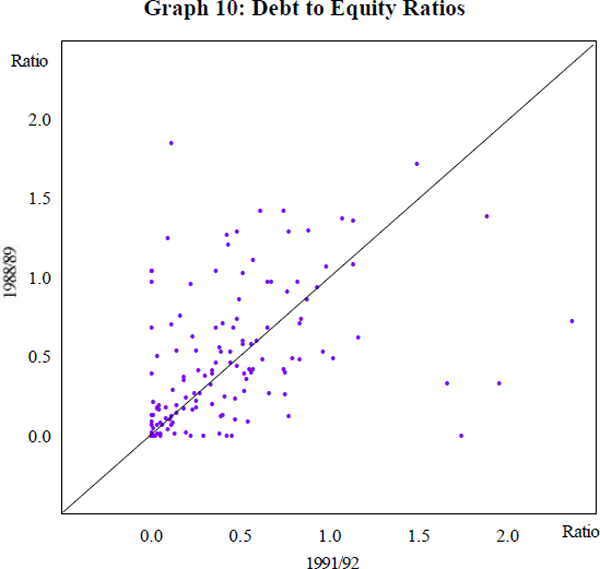
Some companies are still very highly geared and many have continued to increase leverage. This suggests that while gearing has declined in aggregate and for most companies, there may still be some companies that need to continue or start the process of restructuring. Overall, however, corporate debt burdens have clearly fallen.
The lower gearing of the corporate sector has helped boost its cash flow and interest cover. This has been greatly aided by the reduction in nominal interest rates which, in turn, reflect the progressive easing of monetary policy and the sharp reduction in inflationary expectations (Graph 11). Cash flows and interest cover are now significantly above their troughs, even though the recovery in profits before interest payments has been relatively modest.
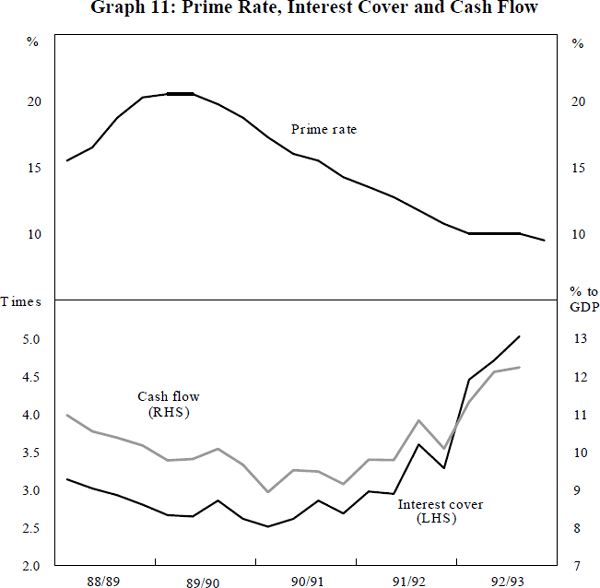
3.2.2 Factors Behind the Financial Restructuring
Many factors have provided firms with an incentive to restructure their financial position. For some firms, the restructuring was forced – sharp declines in interest cover against a backdrop of weak sales and falling asset-backing of debt meant that exposure to debt had to be reduced and cash flows conserved. More generally, at the end of the 1980s there was a change in the relative price of debt and equity:
- real borrowing costs rose in both pre and post-tax terms;
- a long-standing bias favouring debt finance over equity was reduced with the introduction of dividend imputation. The cost of equity fell relative to the cost of debt; and
- market sentiment shifted away from highly leveraged firms.
At the beginning of the period of balance sheet restructuring, real borrowing rates were high, in comparison to earlier standards, in both pre and post-tax terms (Graph 12). The real pre-tax prime rate peaked at around 13 per cent around the end of 1989. Measured in post-tax terms, the peak was around 5−1/2 per cent. These rates were around 2−1/2 percentage points above the previous peak. This would have encouraged firms – even those with healthy balance sheets – to reduce debt outstanding or slow the rate of new debt raisings.
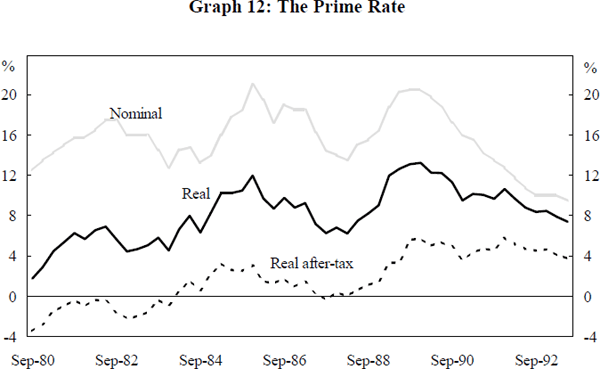
There are two reasons for this. Firstly, for firms wishing to finance a given risky project, the ‘optimal’ degree of leverage will be negatively related to the real interest rate. A higher real interest rate implies that part of the expected return of a project received by equity holders is reduced. They will thus prefer less leverage.[16] Secondly, for firms deciding where to allocate their funds – acquiring capital, paying dividends, acquiring financial assets or repaying debt – the marginal return to paying off debt (effectively the real after-tax borrowing rate) was apparently high by historical standards.
An apparent trend decline in the cost of equity relative to debt provided further incentive for firms to restructure their financial position (Table 3).[17] The gap between the real cost of equity and debt began to narrow in the early 1980s as equity prices rose and post-tax real interest rates began to rise. This narrowing continued later in the decade. The introduction of dividend imputation can explain part of the convergence in the late 1980s. Financial deregulation and innovation have also blurred the boundaries between various types of debt instruments and equity and possibly the risk-return tradeoff associated with the various asset classes. For example, some instruments such as convertible debt, preference shares and subordinated debt have some characteristics of both debt and equity.
| Debt | Equity | Cost of Equity over Debt | |
|---|---|---|---|
| 1969/70–73/74 | −3 | 14 | 17 |
| 1974/75–78/79 | −6 | 17 | 22 |
| 1979/80–83/84 | −2 | 14 | 16 |
| 1984/85 | 3 | 13 | 10 |
| 1985/86 | 2 | 12 | 10 |
| 1986/87 | 1 | 10 | 9 |
| 1987/88 | 1 | 11 | 10 |
| 1988/89 | 2 | 13 | 11 |
| 1989/90 | 5 | 12 | 7 |
| 1990/91 | 4 | 11 | 7 |
| 1991/92 | 5 | 8 | 3 |
On the last point, it appears that changing market attitudes towards gearing may have increased the risk premium on highly indebted firms. The following graph (Graph 13) plots the relative share price performance of companies based on changes in their gearing. In the left hand panel, companies are ranked in order of increased gearing between 1981/82 and 1988/89. Thus, the first quartile are the 25 per cent of companies that increased gearing the most.[18] Conversely, the fourth quartile are the 25 per cent of companies that increased gearing the least. In the right hand panel, companies are ranked in order of decreased gearing between 1989/89 and 1991/92. The first quartile are the 25 per cent of companies that reduced gearing the least while the fourth quartile are those that reduced it the most.
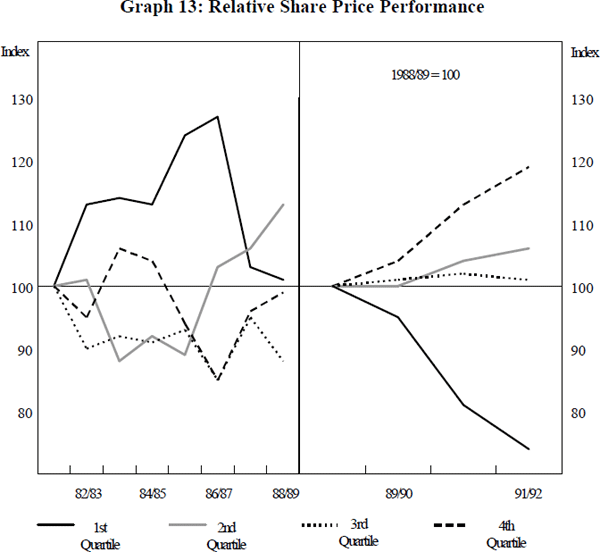
The graph points to a change in market perceptions. In the period up to 1988/89 companies that increased gearing the most (the first quartile) also recorded the largest increase in share prices. The share prices of those companies that increased gearing the least (the fourth quartile) performed relatively poorly.
It is not clear which direction causality runs in this case. Higher share prices may have encouraged some firms to increase leverage and may have also increased the willingness of banks to fund them. Blundell-Wignall and Gizycki (1992) find that credit supply is positively related to the net worth of the corporate sector. Alternatively, higher gearing may have been encouraged by the market if it perceived that firms were moving from non-optimal levels (due to regulation) to their optimum in response to financial liberalisation. Both factors were probably important. The second episode is markedly different. The share prices of companies that recorded the largest reductions in gearing (the fourth quartile) outperformed all others while those that reduced gearing the least (the first quartile) performed the worst.
Footnotes
The data are a sample of 80 large non-financial companies obtained from the Australian Stock Exchange (ASX) STATEX service. See Appendix for a detailed definition of the data. [9]
The STATEX sample is that referred to in footnote 9. The earlier data were obtained from Reserve Bank of Australia Bulletin, Company Finance Supplements. [10]
See MacFarlane (1989, 1990) and Stevens (1991). [11]
The measured fall in the size of corporate balance sheets in 1990/91 is partly due to a new accounting standard (AASB 1024), which forced companies to consolidate all subsidiaries under their control without exception. This has influenced the financial accounts of companies affected by the standard; one of these effects has been to reduce shareholders' funds by removing items to prevent ‘double counting’. This change effects the data from 1990/91 onwards. Adjusting for this does not alter the picture of weak balance sheet growth after 1988/89. [12]
These numbers are taken from ABS Financial Accounts, Cat. No. 5232.0 (December quarter 1992). Debt includes ‘other financial claims’. [13]
The line including ‘non-survivors’ is obtained by adding in the amount of debt and shareholders funds for 13 failed companies to the totals for the 80 company sample. [14]
International comparisons are difficult because of the difference between the banking systems, corporate structures and tax regimes across countries. However debt/equity ratios in Australia in 1992 were well below the level of the major industrialised countries reported in a recent OECD study (O'Brien and Browne (1992)). These countries included the U.S., Japan, Germany, France, U.K., and Canada. In 1989, gearing in the United States was the lowest amongst these countries at just below 70 per cent. Japan recorded the highest gearing of around 260 per cent. [15]
Ryan (1990) provides an analysis of the relationship between leverage and real interest rates. [16]
The cost of equity in the table is measured using a simple earnings/price model in which the required return on equity equals the sum of the earnings-price ratio and the expected growth in real earnings. The latter was estimated as a 10-year moving average of growth in real non-farm GDP. The cost of debt was calculated using the average overdraft rate, adjusted by the marginal corporate tax rate and expressed in real terms. [17]
The change in gearing is measured as the absolute change in the ratio of the book value of debt to the book value of equity. [18]